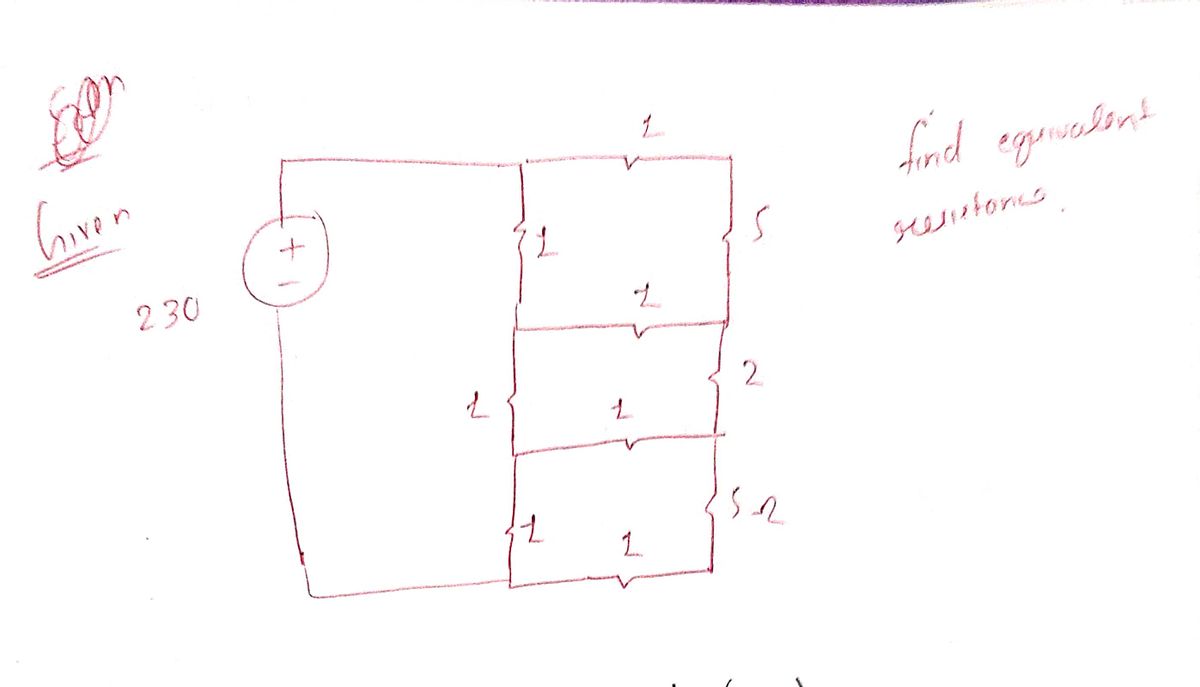Part a ?
Introductory Circuit Analysis (13th Edition)
13th Edition
ISBN:9780133923605
Author:Robert L. Boylestad
Publisher:Robert L. Boylestad
Chapter1: Introduction
Section: Chapter Questions
Problem 1P: Visit your local library (at school or home) and describe the extent to which it provides literature...
Related questions
Question
Part a ?
![**Question 2 [15 points]**
a) What is the equivalent resistance connected to the 230V battery?
b) Use Node-voltage method to find power dissipated in 2 Ohm resistor.
c) Find power supplied by 230 V.
**Circuit Diagram Explanation:**
The circuit diagram provided shows a 230V voltage source connected in series with a combination of resistors. The resistors are arranged in a network that consists of multiple 1Ω resistors, and one each of 5Ω and 2Ω resistors. The arrangement can be described as follows:
- A 1Ω resistor is in series directly with the voltage source.
- Following this, there are three parallel branches of resistors:
- The first branch contains a 1Ω resistor in series with a 5Ω resistor.
- The second branch contains two 1Ω resistors in series.
- The third branch contains a 1Ω resistor in series with a 2Ω resistor, and another 5Ω resistor is connected in parallel to the entire branch.
This configuration creates a complex circuit for which you must calculate the equivalent resistance, and find power values as specified in parts b and c using the node-voltage method and other electrical principles.](/v2/_next/image?url=https%3A%2F%2Fcontent.bartleby.com%2Fqna-images%2Fquestion%2F4b8502c6-77e6-4ad1-93a4-15893327988c%2F54b37195-b868-4bea-8bd6-95a52fac3697%2Fg0z9rac_processed.jpeg&w=3840&q=75)
Transcribed Image Text:**Question 2 [15 points]**
a) What is the equivalent resistance connected to the 230V battery?
b) Use Node-voltage method to find power dissipated in 2 Ohm resistor.
c) Find power supplied by 230 V.
**Circuit Diagram Explanation:**
The circuit diagram provided shows a 230V voltage source connected in series with a combination of resistors. The resistors are arranged in a network that consists of multiple 1Ω resistors, and one each of 5Ω and 2Ω resistors. The arrangement can be described as follows:
- A 1Ω resistor is in series directly with the voltage source.
- Following this, there are three parallel branches of resistors:
- The first branch contains a 1Ω resistor in series with a 5Ω resistor.
- The second branch contains two 1Ω resistors in series.
- The third branch contains a 1Ω resistor in series with a 2Ω resistor, and another 5Ω resistor is connected in parallel to the entire branch.
This configuration creates a complex circuit for which you must calculate the equivalent resistance, and find power values as specified in parts b and c using the node-voltage method and other electrical principles.
Expert Solution
Step 1

Step by step
Solved in 5 steps with 5 images

Knowledge Booster
Learn more about
Need a deep-dive on the concept behind this application? Look no further. Learn more about this topic, electrical-engineering and related others by exploring similar questions and additional content below.Recommended textbooks for you

Introductory Circuit Analysis (13th Edition)
Electrical Engineering
ISBN:
9780133923605
Author:
Robert L. Boylestad
Publisher:
PEARSON

Delmar's Standard Textbook Of Electricity
Electrical Engineering
ISBN:
9781337900348
Author:
Stephen L. Herman
Publisher:
Cengage Learning

Programmable Logic Controllers
Electrical Engineering
ISBN:
9780073373843
Author:
Frank D. Petruzella
Publisher:
McGraw-Hill Education

Introductory Circuit Analysis (13th Edition)
Electrical Engineering
ISBN:
9780133923605
Author:
Robert L. Boylestad
Publisher:
PEARSON

Delmar's Standard Textbook Of Electricity
Electrical Engineering
ISBN:
9781337900348
Author:
Stephen L. Herman
Publisher:
Cengage Learning

Programmable Logic Controllers
Electrical Engineering
ISBN:
9780073373843
Author:
Frank D. Petruzella
Publisher:
McGraw-Hill Education

Fundamentals of Electric Circuits
Electrical Engineering
ISBN:
9780078028229
Author:
Charles K Alexander, Matthew Sadiku
Publisher:
McGraw-Hill Education

Electric Circuits. (11th Edition)
Electrical Engineering
ISBN:
9780134746968
Author:
James W. Nilsson, Susan Riedel
Publisher:
PEARSON

Engineering Electromagnetics
Electrical Engineering
ISBN:
9780078028151
Author:
Hayt, William H. (william Hart), Jr, BUCK, John A.
Publisher:
Mcgraw-hill Education,